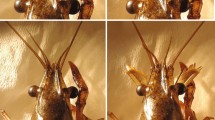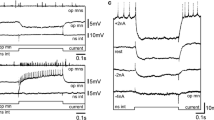Summary
-
1.
Intracellular recordings were made from the somata of central neurons in semi-intact preparations in order to trace sensory pathways in the phasic extensor system.
-
2.
The tonic and phasic muscle receptor organs (MROs or stretch-receptors) produce unitary EPSPs in the phasic extensor motoneurons (Figs. 1, 2).
-
3.
The tonic MRO also produces large, unitary EPSPs in the peripheral inhibitor to the phasic flexors (FI); smaller EPSPs are produced by the phasic MRO (Fig. 2).
-
4.
The MRO-produced EPSPs in FI can summate with central excitation to fire FI (Fig. 3). The EPSPs appear to be monosynaptic and chemical, and show slight posttetanic potentiation (Fig. 5).
-
5.
Each MRO distributes excitation to at least 3 ganglia, but EPSPs in the ganglion where the axon enters are several times larger than EPSPs in neighboring ganglia. The connections made by the MROs are highly specific — the MROs do not contact the fast flexor motoneurons or extensor inhibitors (Figs. 6, 7, 8).
-
6.
The MROs appear to be the exclusive source of monosynaptic sensory input to the extensor motoneurons, but excitation via polysynaptic pathways can be produced by stimulating any sensory root in the abdomen (Fig. 9). Polysynaptic excitation peaks at about 30 ms, which is close to the time when the extensors should fire during the tail flip.
Similar content being viewed by others
References
Alexandrawicz, J.S.: Muscle receptor organs in the abdomen ofHomarus vulgaris andPalinurus vulgaris. Quart. J. micr. Sci.92, 163–199 (1951)
Alexandrowicz, J.S.: Receptor elements in the thoracic muscles ofHomarus vulgaris andPalinurus vulgaris. Quart. J. micr. Sci.93, 315–346 (1952)
Barker, D.L., Herbert, E., Hildebrand, J.G., Kravitz, E.A.: Acetylcholine and lobster sensory neurones. J. Physiol.226, 205–229 (1972)
Eckert, R.O.: Reflex relationships of the abdominal stretch receptors of the crayfish. I. Feedback inhibition of the receptors. J. cell. comp. Physiol.57, 149–162 (1961 a)
Eckert, R.O.: Reflex relationships of the abdominal stretch receptors of the crayfish. II. Stretch receptor involvement during the swimming reflex. J. cell. comp. Physiol.57, 163–174 (1961 b)
Fields, H.L.: Proprioceptive control of posture in crayfish abdomen. J. exp. Biol.44, 455–468 (1966)
Fields, H.L., Evoy, W.H., Kennedy, D.: The reflex role played by efferent control of an invertebrate stretch receptor. J. Neurophysiol.30, 859–874 (1967)
Fields, H.L., Kennedy, D.: Functional role of muscle receptor organs in crayfish. Nature106, 1232–1237 (1965)
Hughes, G.M., Wiersma, C.A.G.: Neuronal pathways and synaptic connections in the abdominal cord of the crayfish. J. exp. Biol.37, 291–307 (1960)
Jansen, J.K.S., Njå, A., and Walløe, L.: Inhibitory control of the abdominal stretch receptors of the crayfish. II. Reflex input, segmental distribution, and output relations. Acta physiol. scand.80, 443–449 (1970)
Kennedy, D., Evoy, W.H., Fields, H.L.: The unit basis of some crustacean reflexes. Symp. Soc. exp. Biol.20, 75–109 (1966)
Krasne, F.: Excitation and habituation of the crayfish escape reflex: the depolarizing response in lateral giant fibres of the isolated abdomen. J. exp. Biol.50, 29–46 (1969)
Krasne, F.B., Bryan, J.S.: Habituation: Regulation through presynaptic inhibition. Science182, 590–592 (1973)
Lloyd, D.P.C.: Post-tetanic potentiation of response in monosynaptic reflex pathways of the spinal cord. J. gen. Physiol.33, 147–170 (1949)
Maynard, D.M.: Simpler networks. Ann. N.Y. Acad. Sci.193, 59–72 (1972)
Mellon, DeF.: Electrical responses from dually innervated tactile receptors on the thorax of the crayfish. J. exp. Biol.40, 137–148 (1963)
Mellon, DeF.: The reflex control of rhythmic motor output during swimming in the scallop. Z. vergl. Physiol.62, 318–336 (1969)
Mittenthal, J.E., Wine, J.J.: Segmental homology and variation in flexor motoneurons of the crayfish abdomen. J. comp. Neurol., in press (1977)
Parnas, I., Atwood, H.L.: Phasic and tonic neuromuscular systems in the abdominal extensor muscles of the crayfish and rock lobster. Comp. Biochem. Physiol.18, 701–723 (1966)
Roberts, A.: Recurrent inhibition in the giant-fibre system of the crayfish and its effect on the excitability of the escape response. J. exp. Biol.48, 545–567 (1968)
Sandeman, D.C.: The site of synaptic activity and impulse initiation in an identified motoneurone in the crab brain. J. exp. Biol.50, 771–784 (1969)
Snow, P.J.: Central patterning and reflex control of antennular flicking in the hermit crab,Pagurus alaskensis (Benedict) J. exp. Biol.63, 17–32 (1975)
Stretton, A.O.W., Kravitz, E.A.: Intracellular dye injection: the selection of Procion yellow and its application in preliminary studies of neuronal geometry in the lobster nervous system. In: Intracellular staining in neurobiology (eds. S.B. Kater, C. Nicholson), pp. 21–40. Berlin-Heidelberg-New York: Springer 1973
Treistman, S.N., Remler, M.P.: Extensor motor neurons of the crayfish abdomen. J. comp. Physiol.100, 85–100 (1975)
Wiersma, C.A.G.: Giant nerve fiber system of the crayfish. A contribution to comparative physiology of synapse. J. Neurophysiol.10, 23–38 (1947)
Wiersma, C.A.G., Furshpan, E., Florey, E.: Physiological and pharmacological observations on muscle receptor organs of the crayfish,Cambarus clarkii Girard. J. exp. Biol.30, 136–150 (1953)
Wiersma, C.A.G., Pilgrim, R.L.C.: Thoracic stretch receptors in crayfish and rocklobster. Comp. Biochem. Physiol.2, 51–64 (1961)
Wiese, K.: Mechanoreceptors for near-field water displacements in crayfish. J. Neurophysiol.39, 816–833 (1976)
Wine, J.J.: Escape reflex circuit in crayfish: Interganglionic interneurons activated by the giant command neurons. Biol. Bull.141, 408 (1971)
Wine, J.J.: Crayfish escape behavior. II. Command-derived inhibition of abdominal extension. J. comp. Physiol.121, 173–186 (1977a)
Wine, J.J.: Neuronal organization of crayfish escape behavior: Inhibition of the giant motoneuron via a disynaptic pathway from other motoneurons. J. Neurophysiol., in press (1977b)
Wine, J.J., Hagiwara, G.: Crayfish escape behavior. I. The structure of efferent and afferent neurons involved in abdominal extension. J. comp. Physiol.121, 145–172 (1977)
Wine, J.J., Hagiwara, G.: Durations of unitary synaptic potentials help time a behavioral sequence. Science, in press
Wine, J.J., Mistick, D.: The temporal organization of crayfish escape behavior: delayed recruitment of peripheral inhibition. J. Neurophysiol.40, 904–925 (1977)
Zucker, R.S.: Crayfish escape behavior and central synapses. I. Neural circuit exciting lateral giant fiber. J. Neurophysiol.35, 599–620 (1972a)
Zucker, R.S.: Crayfish escape behavior and central synapses. II. Physiological mechanisms underlying behavioral habituation. J. Neurophysiol.35, 621–637 (1972b)
Author information
Authors and Affiliations
Additional information
Supported by N.S.F. Grant BNS 75-17826. I thank G. Hagiwara for technical assistance, D. Kennedy and G. Hagiwara for criticism of the manuscript, and Cecilia Bahlman for preparation of the manuscript
Rights and permissions
About this article
Cite this article
Wine, J.J. Crayfish escape behavior. J. Comp. Physiol. 121, 187–203 (1977). https://doi.org/10.1007/BF00609611
Received:
Issue Date:
DOI: https://doi.org/10.1007/BF00609611




